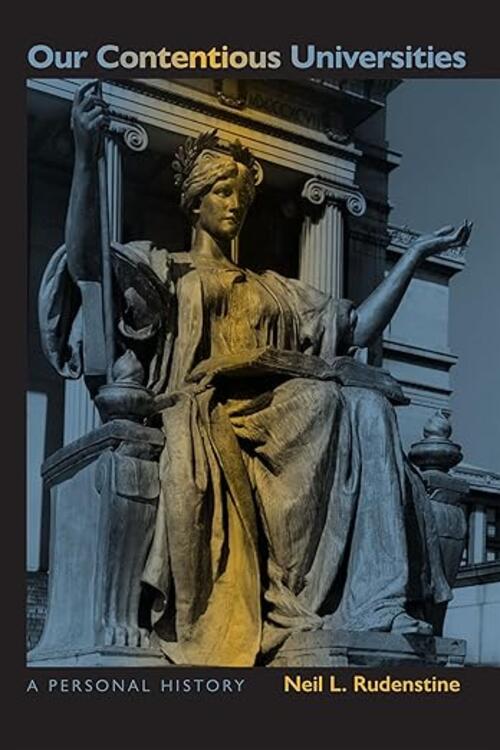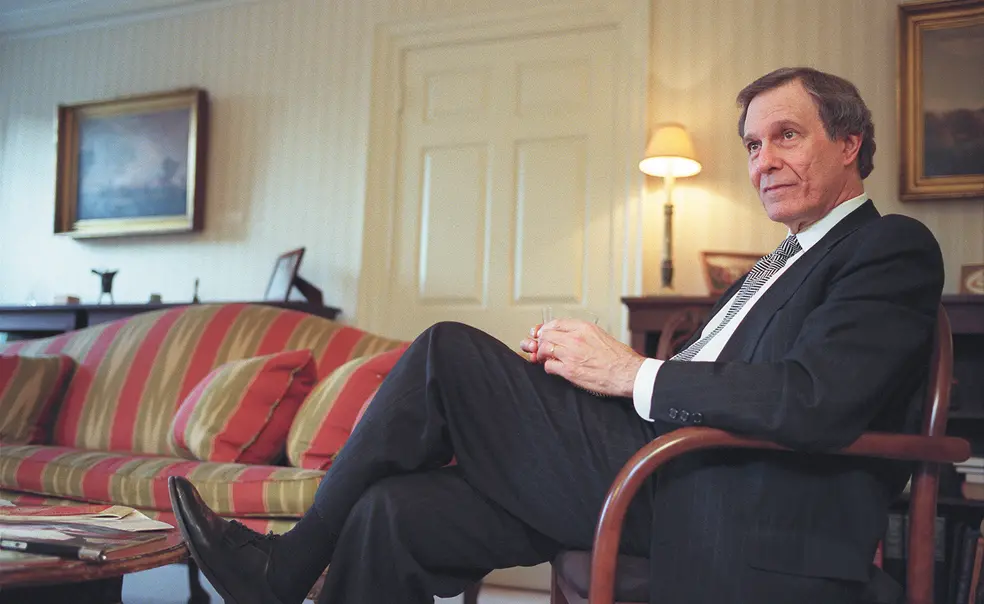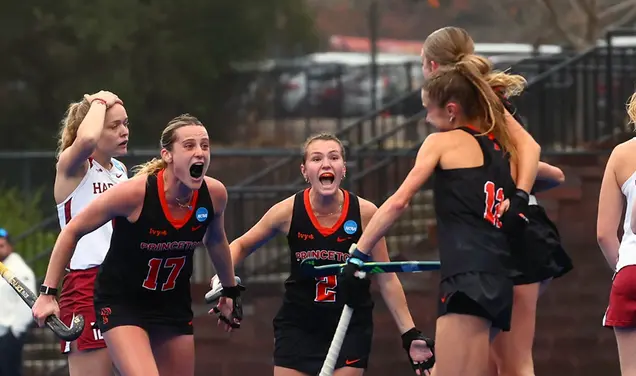Neil Rudenstine ’56 Examines the Evolution of Modern Higher Ed
The book: Neil Rudenstine draws on his decades of experience in academia in Our Contentious Universities (The APS Press) to reflect on the changing landscape of higher education over the past few decades. Starting with the late 1960s, Rudenstine offers his observations on the evolution of protest culture starting with anti-Vietnam War events held on several campuses to movements around modern issues like climate change and gun control. He also reflects on the transformations of universities themselves into decentralized departments competing for university resources. Rudenstine argues that sources of division and conflict are at the root of the contentious environments felt on campuses today.

The author: Neil Rudenstine ’56 graduated from Princeton with a degree in English. His long academic career included serving as provost of Princeton and as president of Harvard University. He is the author of several books including Sidney’s Poetic Development, English Poetic Satire, and In Pursuit of the Ph.D.
Excerpt:
Few people doubt that the last decade and a half have been highly contentious in American higher education. Students have been more activist than at any moment since the 1960s. Many politicians, the media, and large sections of the general public are — in various ways — critical of our colleges and universities. The institutions themselves are often internally divided or fragmented, such that different individuals and groups are sometimes at odds with one another. As a result, the task of leading and administering these institutions is simply far more difficult than it was not long ago.
The recent issues are manifold in nature: Climate-crisis demonstrations in favor of university divestment from fossil-fuel stocks; the creation of new graduate-student unions; the attack in the courts on “affirmative action” and diversity; various controversies in admissions concerning the practice of so-called “athletic admits,” as well as broadsides against alumni/ae “legacy” admits (and the children of major donors); the campaign to erase from their universities the names of several figures labeled imperialist or racist (such as Cecil Rhodes, John Calhoun, and Woodrow Wilson); the desire of some minority-group students to have “trigger warnings,” “safe-spaces” and analogous protections to guard them against potentially offensive speech and actions; the high cost of college attendance, and the heavy burden of student loan-debt; the frequent shouting-down of conservative speakers on many campuses; the continuing effort to eliminate instances of sexual assault; the generalized attack on well-educated (and financially well-off) students and families — as well as on “elitism” (including especially those institutions that are highly-selective and well-endowed); the possible threat of increased government intrusion in higher education; and finally, the extraordinary protests since the very recent Hamas invasion of Israel.
In addition, there have of course been well-publicized attacks on DEI (Diversity, Equity and Inclusion) programs at institutions across the nation; Governor DeSantis’ recent move to transform New College (in Sarasota, Florida) is perhaps the most conspicuous effort of this kind. He placed several of his own chosen candidates on the college’s Board of Trustees, and they promptly organized to do away with the institution’s DEI program. DeSantis also opposed the introduction (in Florida) of the College Board’s Advanced Placement program in African-American Studies, and of course led the way in banning books in libraries. Analogous actions in other states have been less prominent but nevertheless similar. At the same time, one should add that the pressure to use DEI standards can often be at times problematic: a candidate for a UCLA professorship was very recently denied the position for failing to respond “correctly” to questions about diversity and its value.
The above list could easily be expanded, but it offers at least a reasonable synopsis of what has been happening on many American campuses. We have been in a new era, with a broad spectrum of divisive issues at hand, including some that have affected not-for-profit institutions beyond the academy (including several museums).
Not all readers may — quite understandably — be familiar with examples of the protests that have been taking place. A small sample may therefore be helpful. For instance:
- Approximately 50 students staged a sit-in outside the office of Rutgers University’s President to oppose the invitation (in 2014) to Condoleezza Rice as Commencement Speaker. She was regarded by them as a chief instigator of the Iraq war. Students carried signs such as “War criminals out.” Following the protest, Rice withdrew from the invitation to speak.
- The Federalist Society recently (2023) invited a conservative judge to speak at Stanford Law School. Students loudly booed the speaker’s attempt to give his talk. The DEI officer made remarks that tended to side with the student point of view. “In this school,” said the speaker, “the inmates have gotten control of the asylum.” There were no official discipline actions against the students, although the DEI officer was relieved of her duties.
- African-American students affiliated with the Black Lives Matter movement protested an event (in 2017) at the College of William and Mary. They rushed the stage and prevented the ACLU guest from speaking. The students shouted “You protect Hitler too” and “Shame, shame, shame.” A student took the microphone to read a statement. Then the entire event was canceled.
- The Dean of Harvard’s Kennedy School recently refused a fellowship to a candidate for his alleged anti-Israel work for Human Rights Watch. The Dean’s move was protested by many students and faculty — which led to the Dean’s reversal of his decision. The candidate criticized the Kennedy School for its apparent unwillingness to tolerate any criticism of Israel.
- Two protests (2022) at two law schools — Yale and UC Hastings College of Law — were aimed at conservative legal speakers. At Hastings, the speaker was unable to proceed at all because of shoutings; at Yale, students chanted continually, often interrupting the speaker because of his apparent anti-LGBTQ+ views. No disciplinary action followed.
- A recent festival celebrating Palestinian art and culture at the University of Pennsylvania included some speakers that were accused of being anti-semitic. The university administration condemned any such speakers but did not cancel the festival. The university itself did not sponsor the event, but some faculty departments and student groups participated in it. Wealthy Penn alumni condemned the university and its administration for failing to stop the celebration. Then, after the Hamas invasion of Israel in October 2023, they faulted the Penn president for not having opposed the invasion forcefully enough. Wealthy Penn alumni (and at least one Trustee) then withdrew from supporting the university, and some demanded the resignation of the president.
The forces aligned against higher education are now variegated, and they make it more difficult for our institutions to function effectively as places of vital and humane learning. Indeed, a recent survey suggests that this situation may be taking a toll on the length of tenure characterizing college and university presidents. In 2006, the average length of a president’s service was 8.5 years; in 2022 it was 5.9 years. One inevitable question that arises from our current predicament is why (and how) it has come to pass. What major changes, for example, have taken place in our system of higher education — and in our nation — to create the current conditions? If we examine the significant events that have occurred at many of our colleges and universities not only recently, but since (for example) the 1950s and 1960s, does the pattern help us understand the similarities — and the differences — of our very recent situation? That pattern of change is not a simple one, but if we are able to illuminate it, we may be in a better position to comprehend our present predicament more fully.
In the following pages, I have described my own views of what has happened, based partly on my personal experience as a student, faculty member, and administrator since the 1950s. Because my experience has been primarily at two private well-endowed universities — Princeton and Harvard — it is obviously limited in a number of important ways. At the same time, many of the most contentious events at these institutions mirrored to a great extent what was happening elsewhere in the nation’s higher education system. In addition, I have of course relied in this volume on research, reading, discussions with colleagues and students, and visits to a number of colleges and universities. In effect, this book is partly a memoir, and partly a personal history. While it does take issue with some views recently put forward to characterize the protests of the 1960s and early 2000s, it also deals with several other significant developments that did not bear directly on those disruptions. For example, some chapters are devoted to the admission of women to many all-male institutions, and the struggle of many small colleges to avoid bankruptcy. In short, not everything in the following pages concerns “contentiousness” although that is obviously the central focus.
Indeed, a major question that the current volume poses is the following: given the substantial nature and scale of university changes during the past half-century or more, have we entered what is in effect a new era when the probability of frequent protest and disruption is more likely than before? Many of our universities are simply larger and — very important — highly de-centralized; more composed of a large number of semi-autonomous parts (such as programs, centers, institutes, departments and schools); highly diverse in political, ethnic, racial, sexual, geographic and other terms; and consequently more likely to give rise to conflict because there are simply far more actors in a complex drama in which any one of a number of individuals or groups may find themselves at odds with others, or with the institution itself.
Each semi-autonomous part of a university may seek funds — and may accept them from the wrong kind of donor. Each Director or Dean or President may make a decision or statement that antagonizes one group or another. Each invited speaker may be shouted down by a group that disagrees with the speaker’s point of view. Each athletic coach may recommend the wrong kind of admission decision for the wrong reasons. In other words, the possibility for error or serious misjudgment is far more likely when there are so many centers of power with such a diversified population as now comprises so many institutions of higher education.
In addition, the nation and world in which these institutions function are themselves riven in ways that are contentious. So long as there are deeply serious political, economic, social and other divisions and disturbances in our own society — or in international affairs — it is likely that some or many of our students will be affected by them and may be moved to protest in one form or another. As a result, the possibility of intermittent if not continuous contention and disruption may simply be part of our current and future college and university situations.
Perhaps there will be one or more future episodes (as happened after World War II) that will somehow unite much of the nation (and perhaps higher education) so that contentiousness will greatly lessen or virtually disappear for a period of time. Perhaps not. If not, we may be compelled to live indefinitely with something like our recent and current state of affairs: exceptionally difficult; far less than ideal; mirroring to some extent the current state of our domestic political and other problems, as well as the world’s problems.
Excerpted from Our Contentious Universities by Neil Rudenstine. Copyright © 2025. Printed with permission of the publisher The APS Press.
Reviews:
“A fascinating and thought-provoking ‘personal history’ of American higher education, and especially of Princeton and Harvard, since the 1950s, and a compelling read.” — James Turner, Cavanaugh Professor of Humanities Emeritus at the University of Notre Dame
“The chapters in which Neil L. Rudenstine weaves himself into events, some with significance, are very effective — readable and meaningful.” — W. Bruce Leslie, SUNY Distinguished Service Professor Emeritus
"Neil Rudenstine’s latest book is a two-for-one commentary on American universities, the envy of the world and yet a source of bitter domestic controversy today. It thoughtfully examines the last 75 years of American higher education, linking changes in universities to broader changes in politics, economics, technology, international affairs, society and culture. Rudenstine himself has been an important participant-observer in these changes. Thus, the book is also a fascinating personal memoir of these 75 years of development and turmoil. It is hard to imagine a timelier or more important book." ― Robert D. Putnam, author of Bowling Alone and The Upswing: How America Came Together a Century Ago and How We Can Do It Again
"American higher education is a great success story of the last 75 years. Yet as this book shows, our universities are often the crucibles in which challenging issues of our society are contested. And while our universities are still admired around the world, the values they have historically embodied are increasingly coming under critical attack. Neil Rudenstine describes these challenges, and offers insights he gained in the leadership of two of the most prominent universities in the United States. His personal story reveals consistently thoughtful decisions and considerable, understated political skill. This book should be required reading for those who seek to either lead or criticize our universities today." ― Robert Kasdin, former Executive Vice President of University of Michigan and former Senior Executive Vice President of Columbia University.











1 Response
Alvin S. Felzenberg *78
2 Months AgoEager to Read Rudenstine’s Book
For decades, Neil Rudenstine has distinguished himself for his thoughtfulness, integrity, and common sense. I look forward to whatever counsel he might have into how universities might work their way through the morass they have stumbled into as great institutions, rather than act as guarantors of academic freedom, have become targets of all sides.